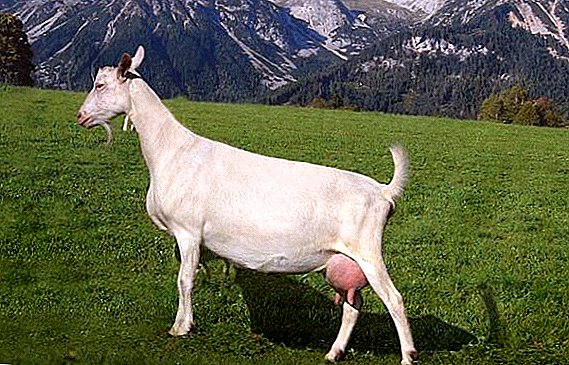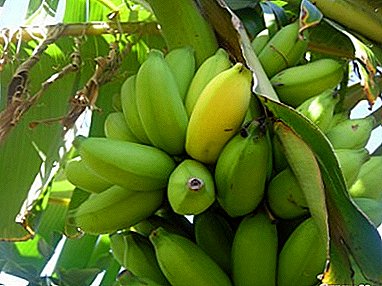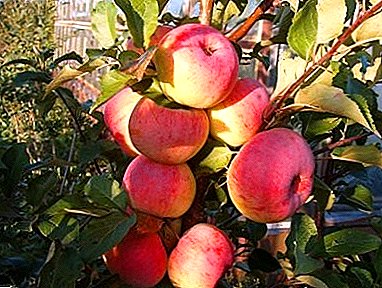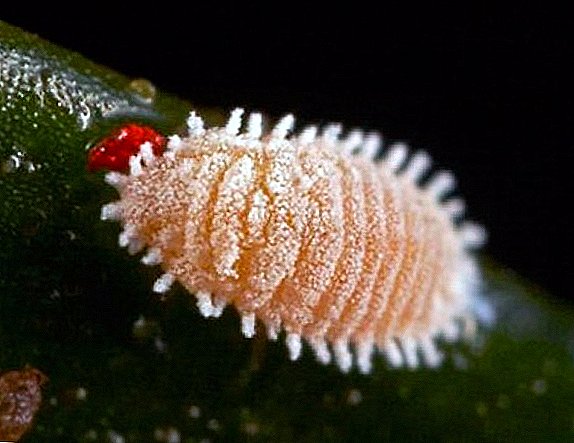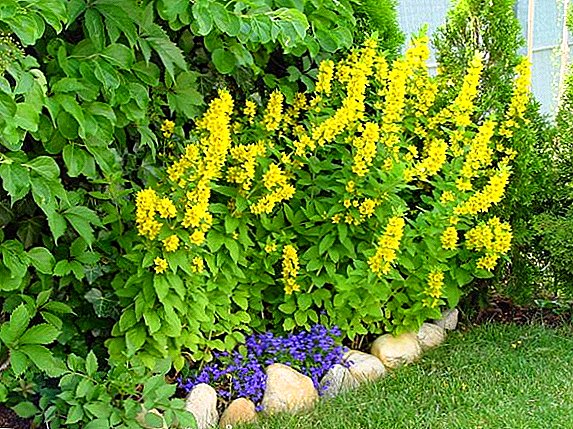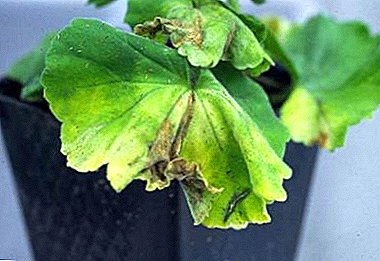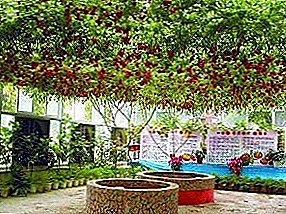
Tomato tree has long been grown in South America. In temperate countries, tomato trees grew, perhaps, only in botanical gardens. It was so until in 1985 the Japanese breeder Nozawa Shigeo presented the Octopus f1 hybrid at EXPO.
Variety made a splash. In the article we will tell all about Sprut tomatoes, how to grow them in a small area.
Miracle tree
Octopus f1 is a perennial (up to 15 years) indeterminant hybrid, which does not stop the growth of the main stem, forming many brushes.
It grows to a height of 5 meters. It forms a crown with a diameter of up to 50 square meters. On one brush matures 5-6 tomatoes, weighing about 150 g

The leaves are oval-shaped. Flowers white and pink. Fruits elongated, different shades: red, yellow, orange. The flesh is different juiciness, aroma, sweet taste.
The introductory video, which is presented below, will help you become better acquainted with the scale of the tomato tree Sprut F1.
The tomato is good in vegetable cocktails, as a part of sauces and gas stations. The fruits are suitable for canning, long-term storage, the manufacture of tomato juice.
There are special reserves, which allow tourists to better get acquainted with this variety of tomatoes Sprut. How to grow them in open ground, in conventional greenhouses, on balconies and loggias, in industrial greenhouses hydroponically?
For most fans, the option of growing a hybrid for one season in a regular greenhouse or open field is suitable. The technology of using effective bio-fertilizers will help to grow a decent harvest.
We start with seedlings
It is better not to experiment with this variety of tomatoes, but to use only purchased tomato seeds octopus f1. The cultivation technology is quite simple and below we look at it in detail:
- We disinfect and soak the hybrid variety in the traditional way for all tomatoes.
- Terms of sowing seedlings from late January to mid-February. Seedlings germinate at a temperature of + 20-25 °. Shoots need additional lighting and heating.
- We dive into large tanks.
- Repotted in open ground from May to mid-June. Transplanted in the phase of 5-7 leaves, with a height of seedlings up to 30 cm. In warm areas, planting seeds directly into the ground is possible.

Choosing a place
Tomatoes can grow in the open field in the beds, but it is better to grow them in barrels or boxes.
- Will need a barrel of at least two hundred liters. You can take a wooden box or a thick plastic bag.
- To remove excess water, knock out the bottom of the barrel. According to the scheme 20 to 20 cm we make centimeter holes in the walls. They provide oxygen access to the root system.
- Install on the sunny side.
- Pour in layers of 10 cm a mixture of equal parts of the earth, turf and bio-fertilizers.
- We make a mound by pouring a bucket of fertile land. We plant the strongest bushes of seedlings, with previously cut off, so that the wounds could be healed to the lower leaves and stepsons.
- We fall asleep with another ten-centimeter layer of soil mixture. Cover with foil until frost stops.
- As the shoot grows back 10 cm, sprinkle with soil to the lower leaflets. Repeat the procedure until the landing tank is completely filled.
Pump air twice a week to improve ventilation.
Cooking biocompost
You can buy ready-made biocompost, but it is better to prepare the mixture yourself:

- To obtain biocompost (urgasy) at home use a bucket or similar capacity.
- Low from the bottom we fix the grid.
- The walls are laid with plastic bags with holes at the bottom. We put in the tableware prepared in this way, all food waste.
- At 10 kg add 1 kg of land and sawdust.
- Stir until the mixture becomes loose, homogeneous in consistency.
- The resulting mixture in layers sprinkle with biological preparation Baikal EM1.
- Prepare a solution of 100 ml of the drug in a bucket of water, with the addition of liquid sweet jam without fruit. We accumulate in large bags, placing the cargo on top.
- Support humidity of the mixture is about 50-60%. The mixture will mature in two weeks. Then the mixture is dried.
Not a day without care
During the summer, it is recommended to fulfill some simple requirements.
- Letters of tomatoes until the barrel is completely filled with soil mixture. In the future, stepchildren and buds do not pinch. You can familiarize yourself with the scheme of pasynkovka tomatoes in the greenhouse here.
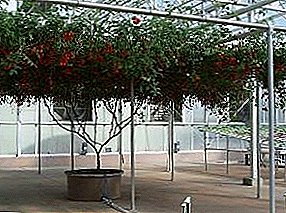 By the middle of the summer we provide whips and brushes with support. Until then, they can hang freely and even travel along the ground.
By the middle of the summer we provide whips and brushes with support. Until then, they can hang freely and even travel along the ground.- Soil moisture is maintained at 60%. For this we carry out loosening and mulching. Water 2-3 times a week with warm water.
- We feed up, starting in July, 2-3 times a week with a chatterbox from a biocompost. We do the following talker: fill the container in 1/3 with mixed soil and biocompost in equal quantities. Fill with separated water to the top. Insist the solution day.
- We feed tomato tree with solutions of mineral or organic fertilizers simultaneously with irrigation.
- When ripe fruits of the first brush remove the leaves. Repeat the operation when the tomatoes on the second brush begin to grow brown.
- Old, withered, yellowing leaves must be eliminated throughout the vegetative season.
- Pour weak aqueous solution of iodine for prevention.
On the balcony
A small fruit tree can be grown on the balcony. It is possible to plant a hybrid all year round, but preferably in the spring. We plant deeper one and a half centimeters. We water, we shelter. Shoots planted in separate containers. We place on the insulated loggia, the southern windowsill.
We mulch with moss, expanded clay, sawdust. As we grow older, we transfer to a shallow, wide pot. We pour with solution with top dressing through the pallet once in 2 weeks.
In winter, watering is reduced, fertilizer is not applied.
Klondike for the farmer
Year-round industrial cultivation of tomato tree is possible only in large greenhouses hydroponically. Greenhouses must be constantly heated and have a continuous lighting system.
The sequence of work may be as follows:
- We equip the greenhouse: we install the compressor, lighting lamps with an optimum range. We purchase glass wool, containers, components for hydroponics, instruments for controlling the concentration, composition of hydroponic solution.
- We make cubes of glass wool for seedlings (20x20x10 cm), impregnate with hydroponic solution. You can ready-made solution, and you can make a homemade solution.
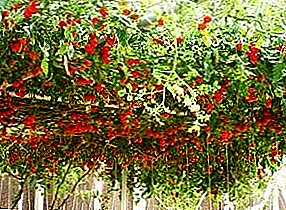 Cutting dice in cubes, laying seeds. Immerse the cubes in half into the solution, poured into the pallets. We moisten them with a nutrient solution and place them in small trays filled with the same solution, so that the cube is half in solution. With the same solution we constantly wet the upper surface of the cube.
Cutting dice in cubes, laying seeds. Immerse the cubes in half into the solution, poured into the pallets. We moisten them with a nutrient solution and place them in small trays filled with the same solution, so that the cube is half in solution. With the same solution we constantly wet the upper surface of the cube.- Two months later transplant the most plump sprout with 5-7 leaves in a large (50x50x30 cm) cube of fiberglass. Connect the cube with tubes to the aerator. As the roots grow in staggered manner, we add tubes for air supply in 30-40cm.
- Lay the cube in a prepared container with a solution. The height of the tank with the solution should be at least 50 cm, and an area of about one and a half meters. The container should be black inside and filled with a hydroponic solution of 30-35 cm. Close the container with the solution of foam black plastic lid with a hole for growth. The black color does not allow one-cell algae to multiply in the nutrient solution.
- From October we provide the hybrid with a 12-hour daylight hours with lamps. In February, the artificial light is turned off.
- We form the trunk of the first 7-8 months. We install a trellis with a height of 3 m. Above the trellis we stretch the grid horizontally. When the trunk grows, carefully lay shoots on it, orienting it in different directions. Pinch the main stem when it exceeds the height of the grid. We do not stepchild. Before the full formation we cut off the flowers. The dates of formation and ripening of fruits at Sprut should coincide with the spring-summer period.
- Once a day, or every other day, we give air to the roots.
- We maintain the temperature of the nutrient solution in summer not higher than + 25 °, in winter the temperature of the solution should not be lower than + 19 °.
- Constantly, every week, we check the composition of the nutrient solution. When changing the concentration of the components of the solution, you need to change the entire solution. If the concentration of the solution is increased, dilute the solution with water. If the concentration of the solution is lowered, add the mother liquor in the required amounts.
The agrotechnical cultivation of five-meter tomato tree in the open ground or in a conventional greenhouse is, of course, impossible. But with proper care, Sprut f1, cultivated as an annual, can please a very decent harvest.
With patience, courage, and finances, you can try the hydroponic method and grow a giant tomato tree. We hope this review has helped you get more information about Sprut tomatoes, growing them both in the greenhouse and on the windowsill. Do not be afraid to experiment!


 By the middle of the summer we provide whips and brushes with support. Until then, they can hang freely and even travel along the ground.
By the middle of the summer we provide whips and brushes with support. Until then, they can hang freely and even travel along the ground. Cutting dice in cubes, laying seeds. Immerse the cubes in half into the solution, poured into the pallets. We moisten them with a nutrient solution and place them in small trays filled with the same solution, so that the cube is half in solution. With the same solution we constantly wet the upper surface of the cube.
Cutting dice in cubes, laying seeds. Immerse the cubes in half into the solution, poured into the pallets. We moisten them with a nutrient solution and place them in small trays filled with the same solution, so that the cube is half in solution. With the same solution we constantly wet the upper surface of the cube.